The amount of solar power or the number of solar panels that you need to run your air conditioner would mainly depend on 2 factors:
- The daily energy consumption of your air conditioner.
- The average amount of sunlight that your solar panels would receive daily.
In other words, the higher the energy consumption of your air conditioner, the more solar panels you would need. Also, the less sunlight you get, the more solar power you would need.
In addition to that, it is also important to note that if you are trying to build an off-grid system, your solar system would consist of:
- Solar panels
- A solar charge controller
- A battery bank
- An inverter
In this article, I will first show you how to calculate the amount of solar power that you need to run your air conditioner and provide a few understandable examples.
And in case you’re trying to run your air conditioner on an off-grid system, I will show you how to size the other solar components that you’d need.
How many solar panels to run an air conditioner?
The process of sizing a solar array boils down to 2 main questions:
- How much energy (Watt-hours or kiloWatt-hours) are you trying to offset?
- How much energy (Wh or kWh) will the solar panels be able to produce in your location?
Since you’re trying to offset the energy consumption of your air conditioner, the first question becomes: How much energy does your air conditioner consume every day?
Also, because the energy production of solar panels depends directly on the amount of sunlight (Solar Irradiance) that they receive, the second question becomes: How much sunlight do you get per day?
The answers to these 2 questions are quantifiable and can be used to determine the amount of solar power that you need to run your air conditioner.
But before we get into that, to give you an idea, the following table estimates the amount of solar power that would be needed to run different air conditioners for 8 hours a day:
| Air Con. Capacity | Est. Energy Consumption over 8 hours | Est. Solar Power Needed (Watts) |
| 5000 BTUs | 2500 Wh (2.5 kWh) | 500 Watts |
| 8000 BTUs | 4500 Wh (4.5 kWh) | 900 Watts |
| 12000 BTUs (1 ton) | 7000 Wh (7 kWh) | 1400 Watts |
| 18000 BTUs (1.5 tons) | 10000 Wh (10 kWh) | 2000 Watts |
| 24000 BTUs (2 tons) | 14000 Wh (14 kWh) | 2800 Watts |
| 36000 BTUs (3 tons) | 20000 Wh (20 kWh) | 4000 Watts |
| 48000 BTUs (4 tons) | 28000 Wh (28 kWh) | 5500 Watts |
| 60000 BTUs (5 tons) | 35000 Wh (35 kWh) | 7000 Watts |
Please note that the values provided in the table are rough estimates and their purpose is to give you an idea of what to expect.
As mentioned above, to estimate the amount of solar power that you need more accurately, you’ll have to estimate (or measure) the amount of energy that your AC unit consumes daily, and determine the average amount of sunlight that you receive (Peak Sun Hours) each day.
Let’s begin with the first item on the list: the energy consumption of your air conditioner.
How much energy does your air conditioner consume?
The energy consumption of an air conditioner depends on the following factors:
- Air conditioner capacity: this is measured in BTUs (British Thermal Units) or tons, the higher the capacity, the more energy is required to run the air conditioner.
- Run time: This is the amount of time for which the air conditioner is left on (8 hours a day for example).
- The efficiency of the air conditioner: The efficiency of an air conditioner is specified using an Energy Efficiency Ratio (EER, SEER, or CEER). In general, newer AC units will be more efficient than older ones.
- Temperature: This is the outdoor temperature vs the indoor temperature setpoint. The higher the difference, the more energy the AC unit will have to consume (longer run time or higher power draw).
- Insulation: This represents the overall quality of your insulation, which includes the insulation of your home or vehicle, and the condition of your ductwork (for ducted systems).
These variables make it a little difficult to estimate the energy usage of an air conditioner, which means that there is no better alternative than to measure it.
In general, you can measure the energy usage of an air conditioner by using an electricity monitoring device such as the Kill-A-Watt meter, which is very simple and easy to use. All you would have to do is plug the device into your electrical outlet and plug your air conditioner into it.
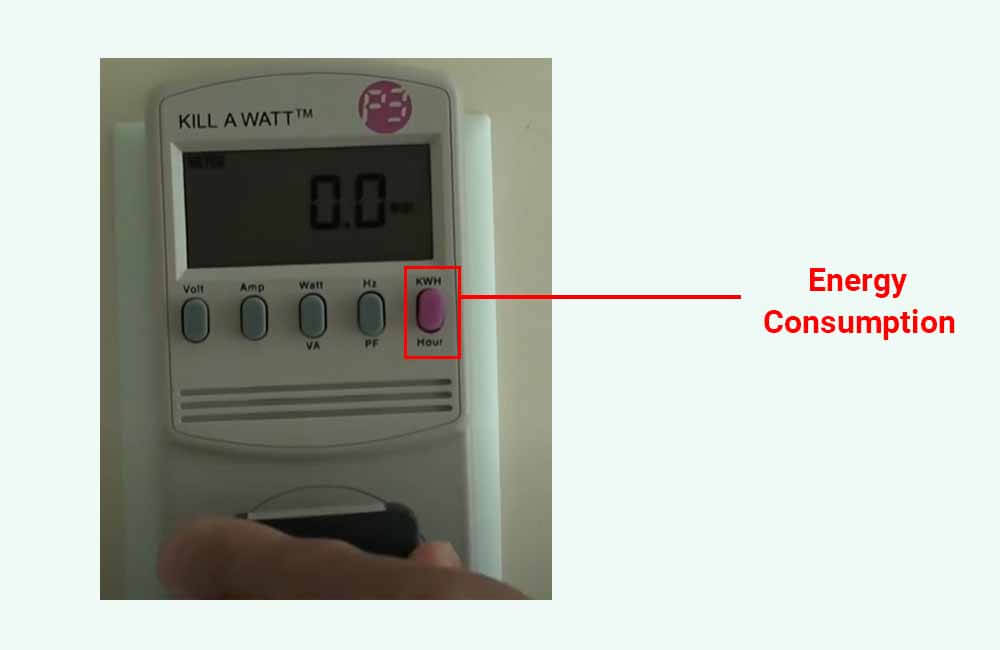
You would then leave your conditioner running for however long it is used to run, and the Kill-A-Watt meter will measure its energy consumption (in kWh) over that amount of time.
For central air conditioners, which usually require a dedicated 240V circuit, you can use a monitoring device such as the Emporia Monitor. The only downside here is that these devices have clamp-on sensors that need to be installed inside your breaker box, so you will need a professional electrician.
However, if you just want to get an idea and you are okay with rough estimates, for now, you can use the following rule of thumb:
Energy Consumption (Watt-hours) = Power Usage (Watts) x Run Time (hours) x 0.75
For example, consider an 8000 BTU window air conditioner that has a power rating of 700 Watts. Assuming this air conditioner runs for 8 hours a day, its average daily energy consumption can be estimated as such:
Energy Consumption (Watt-hours) = Power Usage (Watts) x Run Time (hours) x 0.75
Energy Consumption (Watt-hours) = 700 Watts x 8 hours x 0.75
Energy Consumption (Watt-hours) = 4200 Watt-hours (Wh)
Energy Consumption (kiloWatt-hours) = 4.2 kiloWatt-hours (kWh)
If you don’t know the Power Usage (Watts) of your air conditioner, please refer to this article: How many watts does an air conditioner use?
In the article, I explain a couple of ways to determine the wattage of your AC unit, but I also explain why this rule of thumb might not be accurate.
In any case, once you have an energy consumption value, the next step would be to determine the average daily amount of sunlight that you get (Peak Sun Hours).
How much sunlight do you get per day?
As mentioned above, and as you probably already know, solar panels rely on the energy of the Sun to generate electricity.
In general, sunlight is measured in W/m² (Watts per Square Meter) and is referred to as Solar Irradiance. A solar panel needs exactly 1000W/m² or 1kW/m² of Solar Irradiance to produce 100% of its rated power.
For example, a 200W solar panel will only produce 200 watts of power at a certain moment, if it receives 1000W/m² of solar irradiance at that particular moment.
If the same 200W solar panel only receives 800W/m², it will only produce about 160 watts of power. However, Solar Irradiance does not represent energy, it represents power.
The amount of energy that a certain location receives from the sun is measured in kWh/m² (kiloWatt-hours per Square Meter) and is referred to as Peak Sun Hours. 1 Peak Sun Hour is equivalent to 1kWh/m².
For example, consider a location that we’ll refer to as location A.
Now, let’s say location A – on average – receives 6 kWh/m² of sunlight energy per day (from sunrise to sunset), location A could be said to receive 6 Peak Sun Hours per day (on average).
These Peak Sun Hours can be used to determine the amount of energy that a solar panel or a solar array is capable of producing in this location:
Energy Production (Watt-hours) = Power Rating (Watts) x Peak Sun Hours
Following our example, If we install a 200W solar panel in location A, the average daily energy production of the solar panel can be calculated as such:
Energy Production (Watt-hours) = Power Rating (Watts) x Peak Sun Hours
Energy Production (Watt-hours) = 200 Watts x 6 Peak Sun Hours
Energy Production (Watt-hours) = 1200 Watt-hours
Now, since we know how much energy we need the solar panels to produce (energy consumption of the air conditioner), we can reverse the equation to determine the power rating of the system that we need:
Power Rating (Watts) = Air conditioner’s daily energy consumption (Watt-hours) ÷ Peak Sun Hours
If you know the daily energy usage of your AC unit, all you’ll need is the average Peak Sun Hours that you get on a daily basis.
So, how many Peak Sun Hours do you get?
Using the PVWatts Calculator provided by The National Renewable Energy Laboratory (NREL), you can easily determine the average Peak Sun Hours that you get every day. All you have to do is submit the address at which the solar panels will be installed.
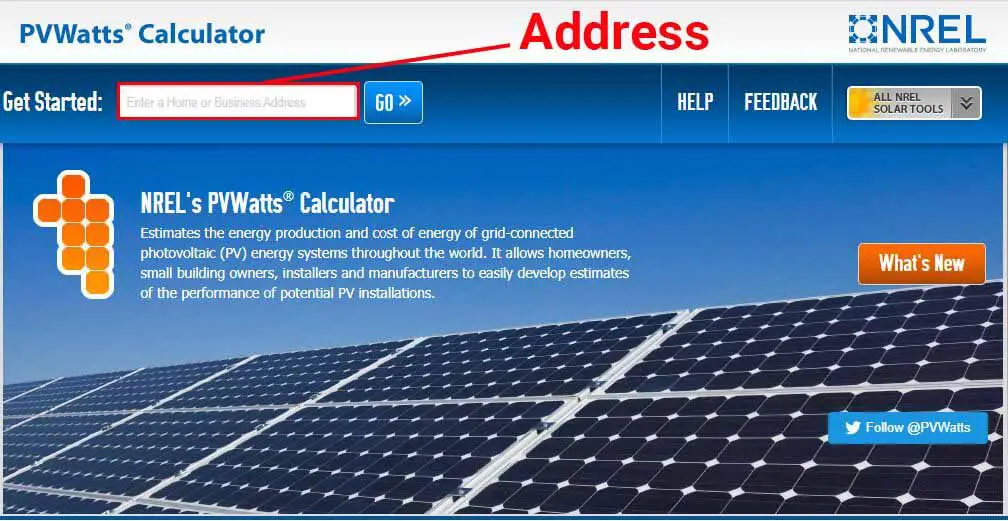
For example, I submitted an address in Phoenix, Arizona, and in the Results section, the PVWatts calculator provided the following table:
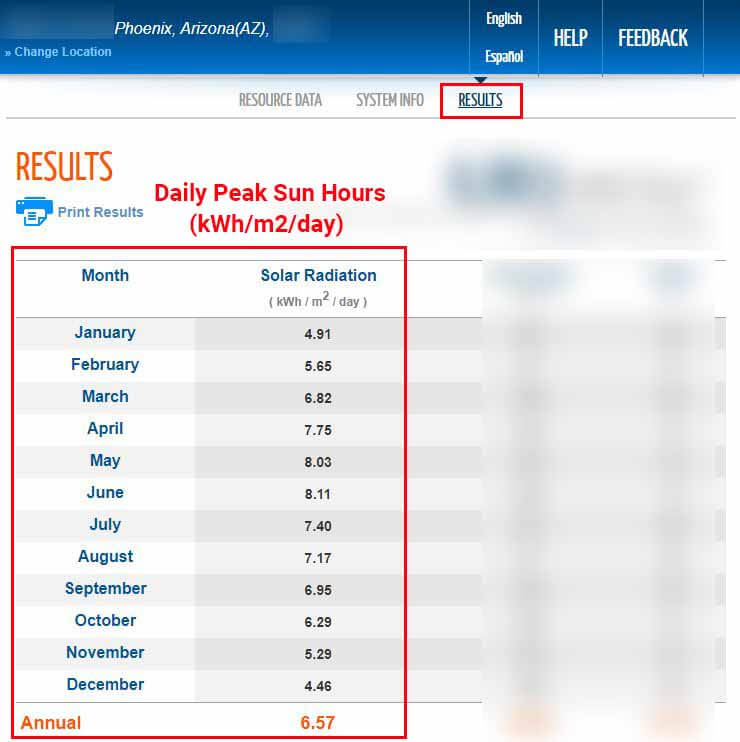
The tool estimates that the annual average Peak Sun Hours that this location receives every day is 6.57 PSH (6.57 kWh/m²/day), but it also provides monthly averages for each month (for example 8.11 Peak Sun Hours per day in June).
For simplicity, I will use the annual average, which is 6.57 Peak Sun Hours per day.
It is also important to note that the calculator assumes that your solar panels will be facing south and tilted at a 20-degree angle (4-5/12 Roof Pitch). If this is not true in your case, you can change these variables in the System Info section of the tool:
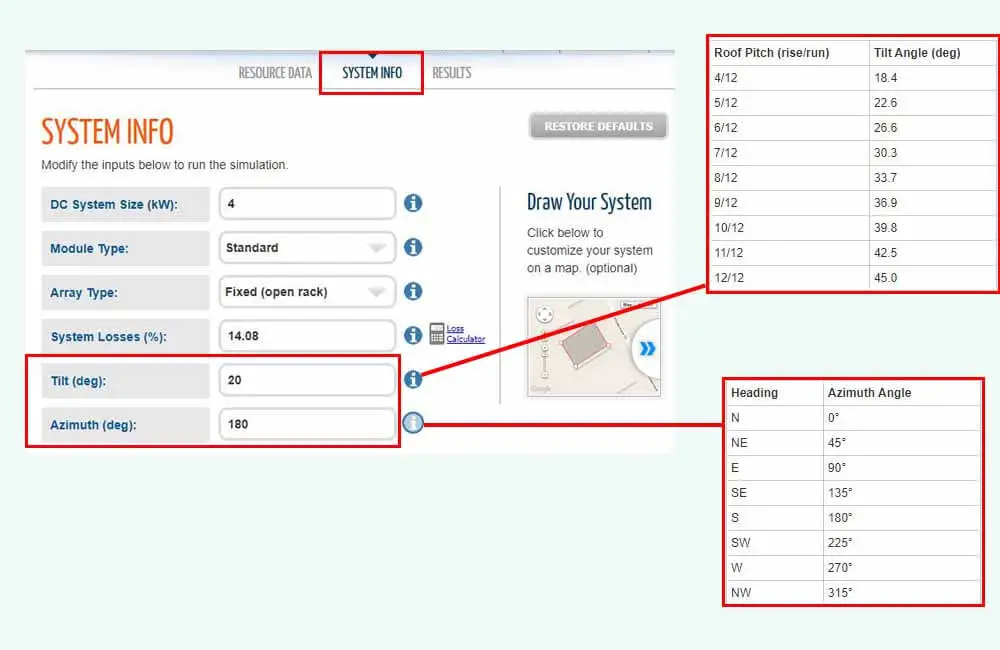
Different Azimuth and tilt angles will result in different Peak Sun Hours.
Now that you’ve estimated or measured the daily amount of energy that your air conditioner consumes, and determined the Peak Sun hours that you get, you can calculate the amount of solar power that you need.
Example:
For this example, consider a 12000 BTU mini-split air conditioner that runs for 8 hours a day. We’ll assume that this is an inverter-driven AC unit, which makes it more efficient.
We’ll also assume that the outdoor temperature is around 95°F and the insulation isn’t bad, during these 8 hours our mini-split should consume around 5 kWh (5000 Wh) of energy.
Also, let’s use the Peak Sun Hours from the previous example (6.57 PSH).
The amount of solar power that we’d need is:
Power Rating (Watts) = Air conditioner’s daily energy consumption (Watt-hours) ÷ Peak Sun Hours
Power Rating (Watts) = 5000 Wh ÷ 6.57 Peak Sun Hours
Power Rating (Watts) = 761 Watts
According to our calculations, we’d need at least 761 Watts of solar power to offset the energy consumption of our 12000 BTU mini-split.
To account for cloudy days, extreme temperatures, and system losses, it should be appropriate to bump this number up to 900 Watts. If we go for 900 Watts of solar power, we would need 9 100W solar panels, or 3 residential solar panels rated at 300 watts each.
Now, if you’re building an off-grid system to run your air conditioner, the setup would look like this:
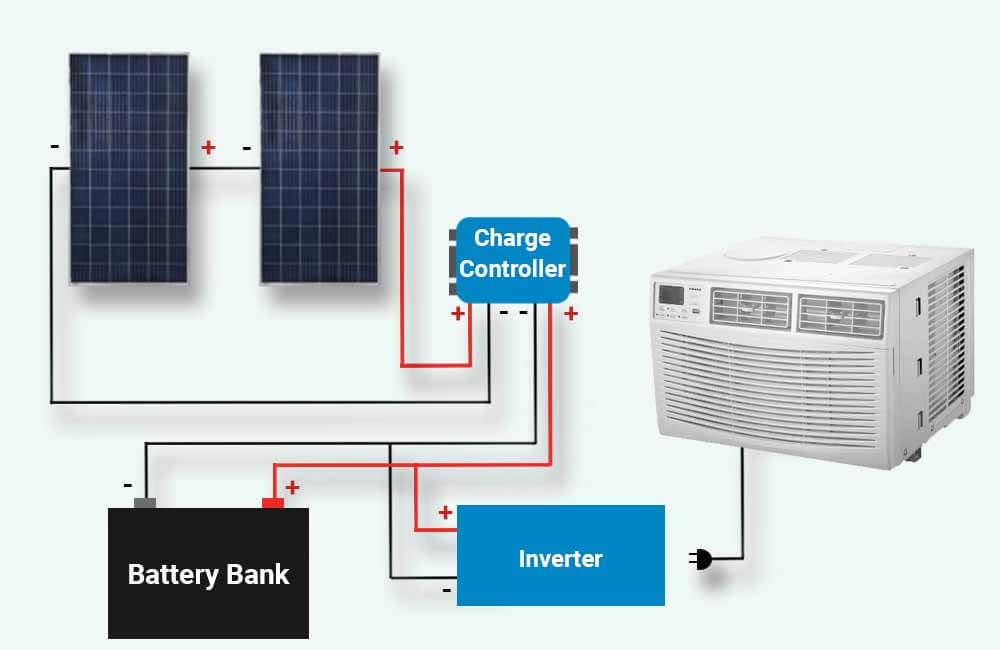
We’ve already estimated the amount of solar power that you need, the next step would be to size the battery bank.
How many solar batteries do you need to run your air conditioner?
The job of the batteries in a solar installation is to store all the energy generated by the solar panels and make that energy available for use at all times. In other words, the battery bank should be large enough to store and supply the energy demands of the air conditioner.
In general, the battery bank would consist of multiple batteries, and each battery would have voltage (V: Volts) and charge (Ah: Amp-hours) ratings. For example, a 4800 Watt-hour battery bank would consist of 4 12V-100Ah batteries (4 x 12 x 100 = 4800). The more batteries, the higher the capacity of the battery bank.
Now, the problem is that the capacity of a battery bank doesn’t matter as much as its Usable Capacity.
Let me explain.
When you buy a battery, the manufacturer will usually recommend a certain Depth of Discharge (DoD), which represents the percentage of the battery’s capacity that can be used.
For example, consider a 12V-100Ah battery. If the manufacturer recommends a DoD of 50% for this battery, it would mean that the battery should only be discharged to 50% of its rated capacity before it needs to be disconnected or recharged.
If the manufacturer recommends a DoD of 80%, the battery should be discharged to 20% of its capacity.
If the recommended Depth of Discharge is repeatedly exceeded, the battery will lose big chunks of its capacity quicker than it should. This damage would be irreversible.
For a more in-depth explanation, please refer to this article: how many 12-volt batteries to run an air conditioner?
What you should know is that there are 2 types of batteries that you would usually find on the market:
- Lead-Acid batteries: These batteries are cheaper but generally have a DoD of 50% and fewer charge/discharge cycles.
- Lithium batteries: These batteries are more expensive but generally have a recommended DoD of 80% (up to 100%) and 3 to 5 times the charge/discharge cycles of a lead-acid battery.
The fact that lithium batteries can be discharged deeper (up to 100% DoD), means that you would need fewer lithium batteries than lead-acid batteries to provide the same amount of energy.
To give you an idea, the following table compares estimates of the battery capacity of both lithium and lead-acid batteries that are required to run different air conditioners for 8 hours:
| Air Con. Capacity | Est. Energy Consumption over 8 hours | Required Lithium Battery Capacity (in AH @ 12V) | Required Lead-Acid Battery Capacity (in AH @ 12V) |
| 5000 BTUs | 2500 Wh (2.5 kWh) | 260 Ah | 420 Ah |
| 8000 BTUs | 4500 Wh (4.5 kWh) | 470 Ah | 750 Ah |
| 12000 BTUs (1 ton) | 7000 Wh (7 kWh) | 730 Ah | 1160 Ah |
| 18000 BTUs (1.5 tons) | 10000 Wh (10 kWh) | 1050 Ah | 1700 Ah |
| 24000 BTUs (2 tons) | 14000 Wh (14 kWh) | 1500 Ah | 2300 Ah |
| 36000 BTUs (3 tons) | 20000 Wh (20 kWh) | 2100 Ah | 3400 Ah |
To determine the battery needed to run your air conditioner, simply divide the daily energy consumption of your AC unit, by the recommended Depth of Discharge of the batteries you’ll be using.
Required Battery Capacity (Watt-hours) = Air conditioner’s daily energy consumption (Watt-hours) ÷ Depth of Discharge (%)
This will give you the battery capacity in Watt-hours. Since most solar batteries are rated at 12 Volts, simply divide those watt-hours by 12 and you’ll have calculated the battery capacity in Amp-hours (at 12V).
Required Battery Capacity (Amp-hours) = Required Battery Capacity (Watt-hours) ÷ 12 (Volts)
For example, if our air conditioner consumes 5000 Wh per day, and we use lithium batteries (80% DOD) to run it, the required battery capacity to run our air conditioner is:
Required Battery Capacity (Watt-hours) = Air conditioner’s daily energy consumption (Watt-hours) ÷ Depth of Discharge (%)
Required Battery Capacity (Watt-hours) = 5000 Watt-hours ÷ 80%
Required Battery Capacity (Watt-hours) = 5000 Watt-hours ÷ 0.8
Required Battery Capacity (Watt-hours) = 6250 Watt-hours
Now let’s assume that we’ll be using 12V-100Ah lithium batteries:
Required Battery Capacity (Amp-hours) = Required Battery Capacity (Watt-hours) ÷ 12 (Volts)
Required Battery Capacity (Amp-hours) = 6250 Watt-hours ÷ 12 Volts
Required Battery Capacity (Amp-hours) = 520 Amp-hours
According to these calculations, we would need (at least) 520 Amp-hours of battery capacity (at 12 Volts). An affordable choice for this example would be 6 of these 12V-100Ah Li Time batteries. A more premium choice would be 6 of these 12V-100Ah Battle Born batteries.
In any case, once you’ve estimated the size of the battery bank that you’ll need, the next step would be to size a solar charge controller. In the next section, I briefly explain why you need a solar charge controller, and provide a tool that’ll do all the sizing for you.
What size solar charge controller do you need?
In a solar installation, the job of the solar panels is to generate energy, and the job of the battery bank is to store that energy and make it available at all times. However, the solar panels and the battery bank are not directly connected.
If you connect a solar panel directly to a battery and leave it connected even after the battery is fully charged, the voltage from the solar panel will cause an excessive amount of current to flow into the battery. This will overcharge the battery and cause irreparable damage.
Also, at night when the solar panel hardly generates any voltage, the battery will end up discharging into the solar panel, which can deplete the battery overnight and cause irreversible damage to the solar panel.
For more details about the necessity of solar charge controllers, please refer to this article: What is a solar charge controller and why do you need one?
Before we get into the specifications of the solar charge controller that you need, let’s talk about the 2 common types of charge controllers that you’ll find on the market.
These 2 types are:
PWM stands for Pulse Width Modulation, and these charge controllers are the cheaper option. A PWM charge controller simply lowers the voltage from the solar panel to match it to that of the battery.
This does protect the battery, but as a consequence, the power output of the solar panel is reduced, which – in general – makes PWM charge controllers highly inefficient.
MPPT, on the other hand, stands for Maximum Power Point Tracking. On the input side, these charge controllers track the voltage for which the solar panel produces maximum power.
On the output side of the charge controller, MPPTs lower the output voltage to protect the battery, but while doing so, the current is increased by the same ratio. This makes these charge controllers highly efficient, and cost worthy.
For the rest of this section, I will focus on MPPT solar charge controllers, as they are the better, long-term option. If you’re looking for an affordable short-term solution, you can learn how to size a PWM charge controller here, or simply use this PWM charge controller calculator.
To make the process of sizing an MPPT even easier, I’ve programmed an MPPT solar charge controller calculator that determines the specifications of the MPPT that you need, and provides links to suitable MPPTs:
To make this even easier, let’s use an example and look at the results that the MPPT calculator provides.
For this example, we’ll assume that our solar array will consist of 8 12V-100W solar panels, which would give us 800 watts of rated solar power.
We’ll also assume that the manufacturer of these solar panels specifies an Open-Circuit Voltage (Voc) of 22.3 Volts for each solar panel.
A good setup for these solar panels would be to wire them in a 4S2P configuration. This means that we would have 2 parallel strings, and each string would consist of 4 solar panels in series, resulting in an 800W solar array. kind of like this:
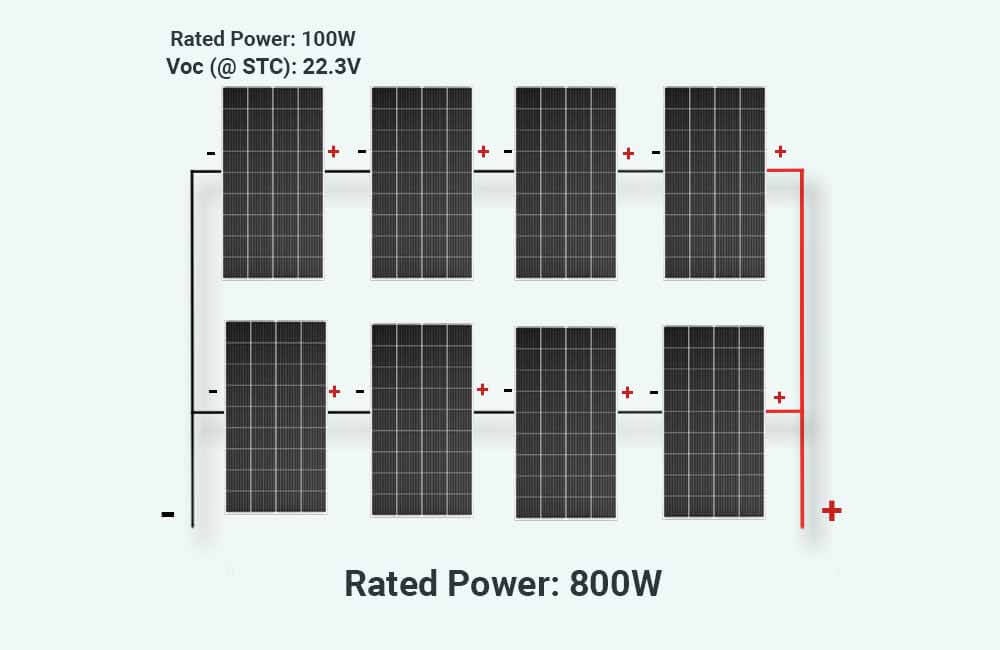
Now for our battery bank, we’ll assume that we will be using 6 12V-100Ah Lithium batteries, which will allow us to store and use up to 7200 Watt-hours of energy (or 5760 Watt-hours at an 80% depth of discharge).
A good way to set up our battery bank would be to wire the batteries in a 3S2P configuration. This means that we would have parallel 2 strings, and each string would consist of 3 batteries wired in series. The setup would look like this:
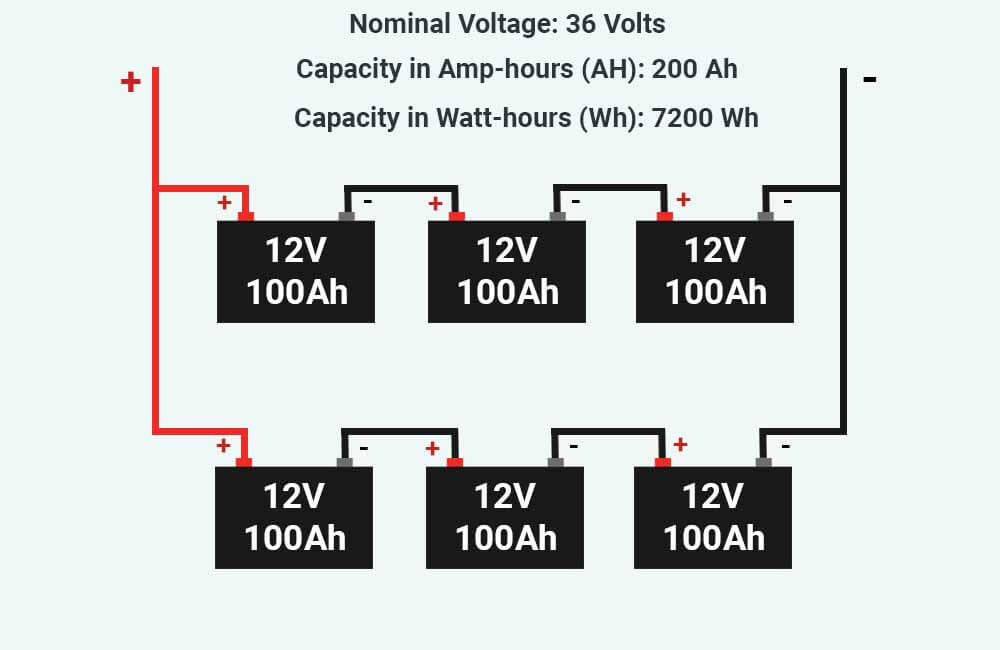
Now our battery bank has a nominal voltage of 36 Volts.
To sum this up, here are the specifications that will be submitted to the MPPT calculator:
- Solar panel wattage: Each of the solar panels is rated at 100 Watts.
- Solar panel open-circuit voltage: Each of these solar panels has an Open-Circuit Voltage (Voc) of 22.3 Volts.
- Battery bank’s nominal voltage: Our battery bank has a nominal voltage of 36 Volts.
- The lowest temperature during sunlight hours: For simplicity, I’ll assume the temperature does not go below 32°F (0°C).
- The number of strings: Our setup Consists of 2 strings of solar panels.
- The number of solar panels in each string: In each string, there are 4 solar panels connected in series.
I’ve submitted these details to the calculators, and here are the results:
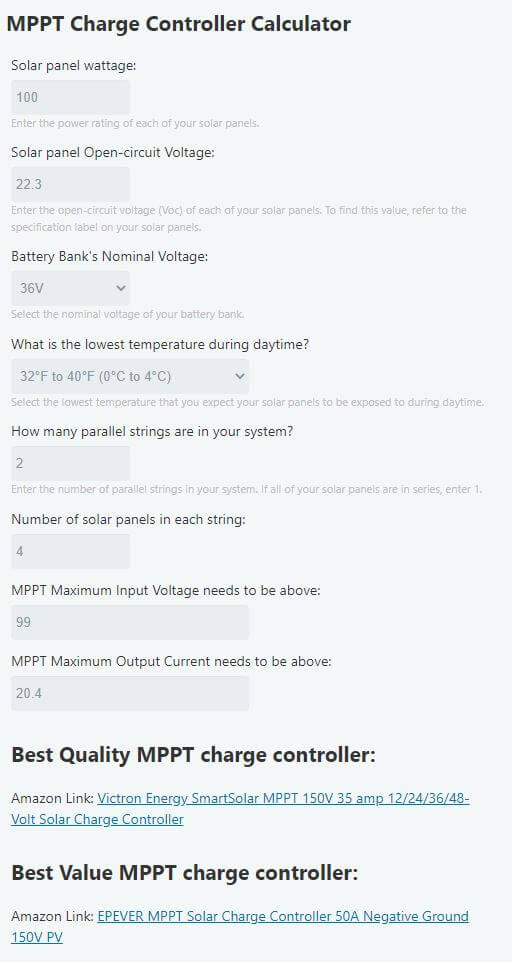
According to the calculator, the MPPT solar charge controller that we choose should have:
- A Maximum Input Voltage rating of more than 99 Volts
- A Maximum Output Current rating of more than 20.4 Amps
However, our charge controller should also be compatible with a 36V battery bank (most charge controllers can only output 12 or 24 Volts).
With all of these details taken into consideration, at the bottom, the tool provides 2 links to a couple of suitable MPPT charge controllers. Both of these suggestions would be suitable for our system and would allow future system expansion.
Now that we’ve sized our solar charge controller, the next and last component to size is the inverter.
What size inverter do you need for your air conditioner?
While your solar panels and battery bank will provide power to your air conditioner, that power will be DC (Direct Current) power. The problem is that most appliances (including your air conditioner) require AC (Alternating Current) power to operate.
The job of an inverter is to convert that low voltage (12/24/26/48V) DC power, into a higher voltage (120V or 240V) AC power that your air conditioner requires.
The inverter would be connected to your battery bank on its input side, and to your air conditioner on its output side (through an outlet or the breaker box). And just like the other solar components, inverters come in different sizes and with different specifications.
The main specifications to look at when shopping for an inverter that can run your air conditioner are:
- Continuous Power rating
- Surge Power rating
- Waveform
- Input Voltage
- Output Voltage
In my article about sizing an inverter for your air conditioner, I provide an in-depth explanation of what each of these specifications represents. However, here are the takeaways:
Continuous Power rating:
The inverter you choose should be able to handle the power usage of your air conditioner. For example, an inverter that can run a 5000 BTU air conditioner (which uses about 500 Watts to run), should have a continuous power rating of 500 Watts or more.
The problem is that a 500W inverter might be able to run a 5000 BTU AC unit, but will probably not be able to start it, as air conditioners of this capacity require up to 3000 watts to start.
This brings us to the next specification.
Surge Power rating:
In general, air conditioners can draw as much as 6 times their running wattage when starting (surge power). The Surge Power rating of the inverter should be higher than the amount of power that your air conditioner requires to kick off.
In general, the Surge Power rating of high-frequency inverters is 2 times their Continuous Power rating (ex; 2000W Cont./4000W Surge). The Surge Power rating of low-frequency inverters is 3 times their Continuous Power rating, and these inverters can run at surge power for up to 20 seconds.
For example, if you have an 8000 BTU air conditioner, it can draw up to 6000 watts of power when you turn it on. In this case, a 3000W inverter will do the trick.
Waveform:
Your air conditioner, and other appliances that are equipped with a motor, will need a smooth alternating voltage to function properly and to last as long as they should.
To provide that smooth AC power, make sure the inverter you choose is a Pure Sine Wave inverter (as opposed to a Modified Sine Wave inverter).
Input Voltage:
Make sure the inverter you choose is designed to operate at the voltage of your battery bank. For example, an inverter that is rated at an input voltage of 12 or 24 Volts, will not work with a 36V or a 48V battery bank.
Output Voltage:
Most appliances in the U.S. run on 120 Volts, which is the voltage that you would find in a standard electrical outlet. Also, most inverters in the U.S. are designed to output 120 Volts.
Chances are, your air conditioner runs on 120 volts too, which would be compatible with most inverters. However, in the case of central air conditioners, you will probably need a 240V source of power. In this case, you would need a split-phase inverter that can provide both 120 and 240 Volts.
In any case, make sure to check the specification sticker on your air conditioner to determine its voltage.


Hello Younes, Iam Electrical Engineer from Greece….congratulations for your nice and very good explanation pv system analysis.
Looking to offer to my clients pv solar systems only for ac or heat pumps as complete package to reduce electricity bill and have no worries how long they gonna use ac or use it less hours for making economy. Free energy from sun for certain appliances….
Thank you once again for your very analysed details.
Thank you for this insight.
Regarding the starting current, I think that air conditioner models with INVERTER technology are more suitable. This can help reduce the capacity of the inverter.